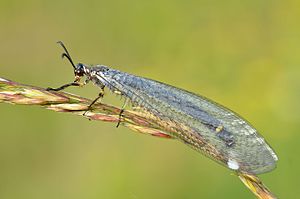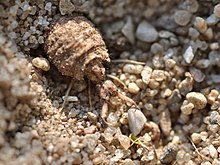Common ant damsel
| Common ant damsel | ||||||||||||
|---|---|---|---|---|---|---|---|---|---|---|---|---|

Common ant damper ( Myrmeleon formicarius ) |
||||||||||||
| Systematics | ||||||||||||
|
||||||||||||
| Scientific name | ||||||||||||
| Myrmeleon formicarius | ||||||||||||
| Linnaeus , 1767 |
The common or common ant virgin ( Myrmeleon formicarius ) is a reticulated winged winglet from the family of ant maids ( Myrmeleontidae ). Like few other species in the family, it is known for the special way its larval form , the so-called ant lion , hunted ants.
features
As an imago , the common ant damsel has a wingspan of 70 to 80 millimeters. This dimension is created by the first and larger pair of wings, whose individual wings can accordingly be 35 to 40 millimeters long. The body length of the Imago is 30 to 40 millimeters. Like the other species of the genus, it has transparent and glass-like wings without drawings, whereby in the other species the first pair of wings is no longer than the second. The head and pronotum also have a pattern that also enables the common ant virgin to be distinguished from the other species.
The body structure of the larva - in this case as with that of other ant maids, the ant lion - is identical to that of other members of the family. In the last stage, the larva has a length of 10.3 to 17.5 millimeters. It is bristled all over the body and especially on the thorax and has a relatively large head. The mouthparts located on this are transformed into suction tongs - an anatomical peculiarity that is present in the larval stages of all netwings. The mandibles and parts of the maxilla are greatly enlarged and folded together, which means that they can enclose food canals. The inside of the maxillae is provided with a venom canal through which digestive enzymes are injected into a prey; on the other hand, the food pulp is sucked out through a second food channel, now digested extracorporeally, and thus fed to the metabolism.
Similar species
The somewhat smaller and closely related dune anthem ( Myrmeleon bore ), which, however, only inhabits sand dunes, where its larva develops in the open field, is one of the similar species of the common ant virgin .
Occurrence
The common ant virgin can be found all over Europe (with the exception of the British Isles ) and in parts of Asia to Japan . It can be found up to heights of 1,000 meters (in the Alps also up to 1,700 meters). The adults live in dry, sandy and stony places with little vegetation, particularly overhanging edges are preferred. Examples of such habitats are inland dunes and sandy heaths. The larvae, which live on the ground according to their way of life, are found particularly in areas exposed to the sun and protected from rain, in open forests and roadsides. Sand chippings, cave entrances, the soles of rock overhangs and locations under roots and on house walls are also popular. The common ant virgin is one of the three species of the genus Myrmeleon represented in Central Europe , the others are the dune ant virgin and Myrmeleon inconspicuus . In addition, it is one of the 11 species of the ant maiden family that occurs in Central Europe.
Hazard and protection
The common ant maiden, together with the spotted- winged ant maiden ( Euroleon nostras ), is one of the most common ant maids in Central Europe, although the spotted- winged ant virgin is usually more numerous. Although the common ant virgin is common in some areas, dwindling numbers of their populations can be observed due to the decline in their habitats. The common and the spotted-winged ant damper therefore both enjoy legal protection.
Way of life and catch of prey
The nocturnal adults become active from dusk and prey on small insects in flight. Due to their flight behavior, they are reminiscent of dragonflies and are therefore also known as "night dragonflies". They also differ from these at a distance through the culled antennae. They are quite good fliers and, like dragonflies, can stay still in one place in flight. The adult insects spend the day mostly motionless in the vegetation and are therefore difficult to spot. They are then usually hidden at knee height in the herb layer.
The larva, the ant lion, also lives predatory and uses the trap funnel known for ant lions, which, however, is only used in the ant lions of around 10% of the species, including the common, the spotted-winged and the dune damsel. In a suitable habitat, the ant lion creates its trap funnel with a diameter of around 80 millimeters by boring itself spirally into the ground. For this, a loose and fine-grained substrate, such as sand, is required. The ant lion itself lurks motionless and is buried in the bottom of the funnel and can remain there for a period of several months. Only the suction cups are then visible. If any prey, mainly ants, falls into the funnel, the ant lion tries to grab it with the suction tongs at lightning speed. If the prey succeeds in evading access, the ant lion tries to prevent it from fleeing by throwing sand at the prey so that it slips off the chasm of the funnel. After the prey has been successfully grabbed and sucked out, the empty shell ( chitin shell ) is flung out of the funnel. The bristle-like hair is used to perceive vibrations within the substrate. The sense of perception is very fine, so that the presence of neighboring ant lions is probably also perceived. One speaks here of intraspecific communication .
Reproduction
After mating, which has so far been little explored, the female lays eight eggs that are difficult to spot in a small pit that she has dug with her abdomen. The larvae that have now hatched or the ant lions go through three larval stages in a period between one and three years, but this can vary depending on the weather. Usually the development takes two years. After development is complete, the larva spins an equally well camouflaged cocoon from which the imago hatches in summer. This then has a life expectancy of three to four weeks and is mainly found between the months of May and August.
Systematics
The common ant damsel was first described by Carl von Linné in 1767 under the name still valid today, including the subspecies Myrmeleon formicarius nigrilabrus , but then contained various synonyms by different authors (including Linnaeus himself).
gallery
Prepared copy in the Überseemuseum Bremen
Illustration of a common ant damsel from the work of Georges Cuvier ("Le Règne Animal")
Individual evidence
- ↑ a b c d e f g Heiko Bellmann: The KOSMOS Insect Guide Kosmos Naturführer, Kosmos (Franckh-Kosmos), 1st edition, 2018, p. 128, ISBN 978-3-440-15528-8 .
- ↑ a b c d e f g h i j k l m n Franziska Anderle: The insect of the year 2010: The common ant maiden Myrmeleon formicarius LINNÉ, 1767 (Neuroptera, Myrmeleontidae) In: Entomologica Austriaca. 17, 2010, pp. 231-236. ( PDF, German )
- ↑ a b c d e f g Information about the common ant damsel on the website of Naturspaziergang (Andreas Haselböck) ( Link )
- ↑ Systematics of the common ant virgin on the Insecta.pro website ( Link )







